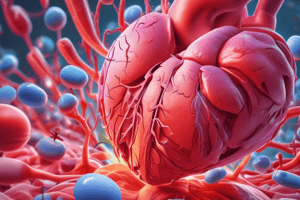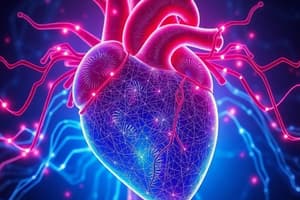Podcast
Questions and Answers
What is the primary cause of heart failure?
What is the primary cause of heart failure?
- Hypertension
- Coronary artery disease (correct)
- Cardiomyopathy
- Pericardial disease
Which factor determines cardiac oxygen demand?
Which factor determines cardiac oxygen demand?
- Heart rate and stroke volume (correct)
- Diastolic blood pressure
- Systolic blood pressure
- Ventricular ejection fraction
What happens in systolic heart failure?
What happens in systolic heart failure?
- The heart's main pumping chamber becomes stiff and unable to fill properly
- The heart's main pumping chamber contracts vigorously
- The heart's main pumping chamber cannot pump blood efficiently (correct)
- The heart's main pumping chamber experiences reduced ejection fraction
What is preload in the context of heart failure?
What is preload in the context of heart failure?
Why is activation of the renin-angiotensin system an advantageous effect of SNS activation?
Why is activation of the renin-angiotensin system an advantageous effect of SNS activation?
Which treatment model emerged during the 1980s-2000s for heart failure?
Which treatment model emerged during the 1980s-2000s for heart failure?
What is the primary goal of treatment in the Neurohormonal Model?
What is the primary goal of treatment in the Neurohormonal Model?
In the Haemodynamic Model, what is the primary treatment goal for heart failure?
In the Haemodynamic Model, what is the primary treatment goal for heart failure?
Name two emerging therapies in the treatment of heart failure according to the Neurohormonal Model.
Name two emerging therapies in the treatment of heart failure according to the Neurohormonal Model.
What are the primary drugs used in the prevention of progression in the Neurohormonal Model?
What are the primary drugs used in the prevention of progression in the Neurohormonal Model?
Mention one passive restraining device used in the treatment of heart failure according to the Neurohormonal Model.
Mention one passive restraining device used in the treatment of heart failure according to the Neurohormonal Model.
What are the conventional drugs used in the treatment of heart failure according to the Haemodynamic Model?
What are the conventional drugs used in the treatment of heart failure according to the Haemodynamic Model?
Why is cardiac stimulation a potentially advantageous effect of the SNS activation?
Why is cardiac stimulation a potentially advantageous effect of the SNS activation?
Why is cardiac stimulation a potentially advantageous effect of the SNS activation?
Why is cardiac stimulation a potentially advantageous effect of the SNS activation?
Diastolic refers to which phase of the heartbeat?
Diastolic refers to which phase of the heartbeat?
Systolic refers to which phase of the heartbeat?
Systolic refers to which phase of the heartbeat?
What happens in diastolic heart failure?
What happens in diastolic heart failure?
Heart failure is best described as:
Heart failure is best described as:
Which of the following is not a cause of heart failure?
Which of the following is not a cause of heart failure?
Which adaptive mechanisms are involved in heart failure?
Which adaptive mechanisms are involved in heart failure?
What is the Frank-Starling mechanism?
What is the Frank-Starling mechanism?
What happens when the myocyte is stretched in the Frank-Starling mechanism?
What happens when the myocyte is stretched in the Frank-Starling mechanism?
How does the Frank-Starling mechanism affect cardiac output?
How does the Frank-Starling mechanism affect cardiac output?
What happens to the Frank-Starling mechanism in heart failure?
What happens to the Frank-Starling mechanism in heart failure?
What are the consequences of an impaired Frank-Starling mechanism in heart failure?
What are the consequences of an impaired Frank-Starling mechanism in heart failure?
What is the major intrinsic cardiac mechanism that allows the heart to adapt to varying amounts of returning venous blood?
What is the major intrinsic cardiac mechanism that allows the heart to adapt to varying amounts of returning venous blood?
What happens when cardiac muscle is stretched an extra amount?
What happens when cardiac muscle is stretched an extra amount?
What term is used to describe the stretching of the cardiac muscle due to increased blood entering the ventricle?
What term is used to describe the stretching of the cardiac muscle due to increased blood entering the ventricle?
The physiologic basis for the Frank-Starling Mechanism is found in:
The physiologic basis for the Frank-Starling Mechanism is found in:
Inotropy refers to the contractility of the:
Inotropy refers to the contractility of the:
Cardiac muscle can alter its intrinsic inotropic state. This means that it can:
Cardiac muscle can alter its intrinsic inotropic state. This means that it can:
Changes in inotropy affect the rate of:
Changes in inotropy affect the rate of:
Cellular mechanisms responsible for changes in inotropy involve:
Cellular mechanisms responsible for changes in inotropy involve:
Inotropic agents can influence inotropy. Which of the following is an example of an inotropic agent?
Inotropic agents can influence inotropy. Which of the following is an example of an inotropic agent?
Name two factors that decrease Calcium viability.
Name two factors that decrease Calcium viability.
What are the factors that can promote Calcium as a positive inotropic agent?
What are the factors that can promote Calcium as a positive inotropic agent?
Ventricular remodelling can occur over months and years in a proportion of patients. This remodelling is primarily characterized by:
Ventricular remodelling can occur over months and years in a proportion of patients. This remodelling is primarily characterized by:
The adaptive response to ventricular remodelling eventually becomes a maladaptive process due to:
The adaptive response to ventricular remodelling eventually becomes a maladaptive process due to:
Which of the following is a contributing factor to the elongation of non-infarcted segments in ventricular remodelling?
Which of the following is a contributing factor to the elongation of non-infarcted segments in ventricular remodelling?
When LV dysfunction is present, adrenergic support is triggered to enable:
When LV dysfunction is present, adrenergic support is triggered to enable:
The deleterious effects of SNS activation in the long-term include:
The deleterious effects of SNS activation in the long-term include:
Plasma norepinephrine levels are high in heart failure and correlate with:
Plasma norepinephrine levels are high in heart failure and correlate with:
What are the potentially advantageous effects of SNS activation?
What are the potentially advantageous effects of SNS activation?
What happens to beta receptors in the heart with constant stimulation?
What happens to beta receptors in the heart with constant stimulation?
How does chronic arterial vasoconstriction affect cardiac remodeling?
How does chronic arterial vasoconstriction affect cardiac remodeling?
What is the correlation between plasma norepinephrine levels and prognosis in heart failure?
What is the correlation between plasma norepinephrine levels and prognosis in heart failure?
Which of the following may be audible in heart failure?
Which of the following may be audible in heart failure?
Name two cardiac abnormalities that may be observed in heart failure.
Name two cardiac abnormalities that may be observed in heart failure.
What are two possible auscultatory findings in heart failure?
What are two possible auscultatory findings in heart failure?
What is the term for difficulty in breathing experienced during physical activity in individuals with heart failure?
What is the term for difficulty in breathing experienced during physical activity in individuals with heart failure?
Name one symptom of heart failure characterized by the swelling of the peripheral tissues.
Name one symptom of heart failure characterized by the swelling of the peripheral tissues.
What is the term for the enlargement of the heart often observed in individuals with heart failure?
What is the term for the enlargement of the heart often observed in individuals with heart failure?
Which term refers to the abnormal accumulation of fluid in the lungs due to heart failure?
Which term refers to the abnormal accumulation of fluid in the lungs due to heart failure?
Which of the following is a symptom/sign of heart failure specifically experienced when lying flat?
Which of the following is a symptom/sign of heart failure specifically experienced when lying flat?
Which treatment approach for heart failure was prominent during the 1950s-1980s?
Which treatment approach for heart failure was prominent during the 1950s-1980s?
What is inotropy in the context of heart failure?
What is inotropy in the context of heart failure?
What is afterload in the context of heart failure?
What is afterload in the context of heart failure?
What are the potential effects of activation of the sympathetic nervous and renin-angiotensin-aldosterone systems in heart failure?
What are the potential effects of activation of the sympathetic nervous and renin-angiotensin-aldosterone systems in heart failure?
What are some symptoms of heart failure?
What are some symptoms of heart failure?
What is the NICE Pathway for Heart Failure?
What is the NICE Pathway for Heart Failure?
What is heart failure?
What is heart failure?
What is preload and afterload?
What is preload and afterload?
What are symptoms of heart failure?
What are symptoms of heart failure?
What are the neurohumoral mechanisms that can have potentially advantageous effects in heart failure?
What are the neurohumoral mechanisms that can have potentially advantageous effects in heart failure?
What are the treatment options for heart failure?
What are the treatment options for heart failure?
Flashcards are hidden until you start studying
Study Notes
Causes and Consequences of Heart Failure
- Heart failure is a syndrome where an abnormality of cardiac function causes the inability of the heart to pump blood at an output sufficient to meet the requirements of metabolizing tissues.
- Heart failure is always secondary to something else, such as coronary artery disease, hypertension, cardiomyopathy, valvular heart disease, or pericardial disease.
- Preload is the stretch of myocardium or end-diastolic volume of the ventricles, while afterload is the force opposing fiber shortening during ventricular ejection.
- The Frank-Starling mechanism is the major intrinsic cardiac mechanism by which the heart can adapt to varying amounts of returning venous blood.
- Inotropy refers to the contractility of the ventricle, and changes in inotropy alter the rate of force and pressure development by the ventricle.
- Afterload is the “load” against which the heart must contract to eject blood, and a major component of it is the aortic pressure.
- Progressive remodeling can occur over months and years leading to maladaptive processes, such as elongation due to eccentric hypertrophy of the myocytes, myocyte slippage, collagen matrix reorganization, and apoptosis.
- Activation of the sympathetic nervous and renin-angiotensin-aldosterone systems are neurohumoral mechanisms that can have potentially advantageous effects, such as cardiac stimulation and peripheral vasoconstriction, but also deleterious effects in the long-term.
- Symptoms of heart failure include dyspnea on exertion, fatigue, orthopnea, cardiomegaly, oedema, pulmonary venous hypertension, raised JVP, and third or fourth heart sounds.
- The NICE Pathway for Heart Failure provides guidance for the treatment of heart failure.
- Treatment options for heart failure include lifestyle changes, medication, devices, and surgery, depending on the severity and underlying cause of the condition.
- Heart failure affects a significant number of people, with 920,000 diagnosed cases in the UK, 60,000 new cases every year, and 4,000 deaths in the UK each year.
Studying That Suits You
Use AI to generate personalized quizzes and flashcards to suit your learning preferences.




